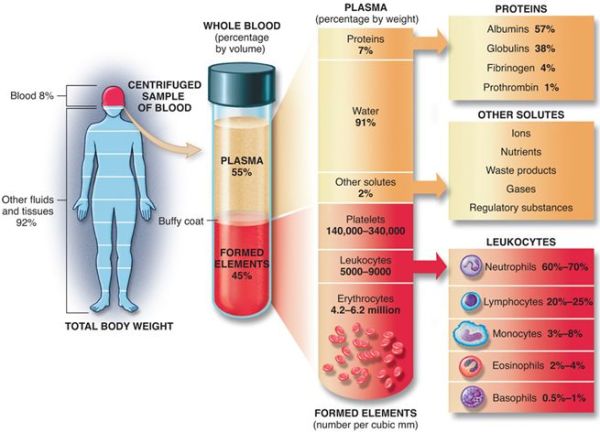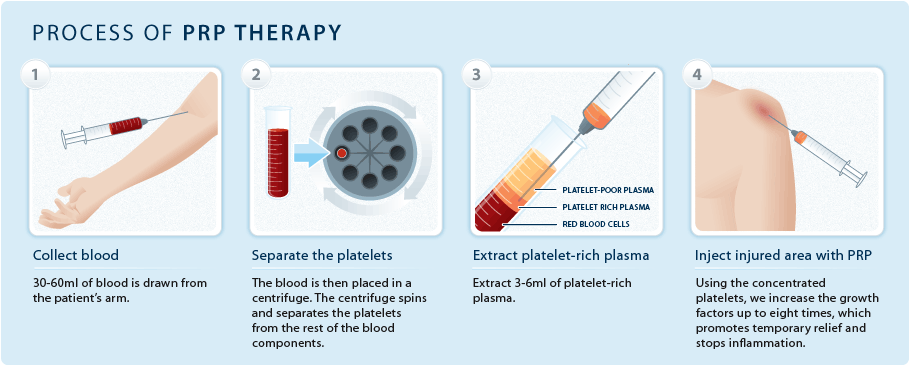PRP (Platelet Rich Plasma)
Regenerative Injection Therapy (RIT) is a treatment option that stimulates the body's inflammatory response to promote healing. The technique has been described and used for many years and is endorsed by the Canadian Association of Orthopaedic Medicine, the American College of Osteopathic Prolotherapy Regenerative Medicine (prolotherapycollege.org), and the American Association of Orthopedic Medicine (aaomed.org). Traditionally, Morrhuate Sodium or dextrose solution was injected into various structures in need of repair. This approach is often referred to as prolotherapy. A newer development over the last 20 years utilizes Platelet Rich Plasma (PRP), that is harvested and processed from the patient's own blood, to stimulate repair.
There is a growing body of animal and human research studies to support the effectiveness of RIT. 2010 and 2012 systematic reviews found that moderate evidence exists to support the use of RIT for pain in the lateral epicondyle. There is also support for use of regenerative therapy for osteoarthritis pain. There are also a number of positive studies for back pain and Achilles tendon injuries.
Dr. Leonardo explains Regenerative Injection Therapy/Platelet Rich Plasma Therapy

Several famous athletes have used PRP treatments to recover sooner than expected from injuries that would require much longer rehabilitation. These athletes include Tiger Woods (Golf), Hines Ward (Football), Rafael Nadal (Tennis), Cristiano Ronaldo (Soccer), Kobe Bryant (Basketball), and Joey Votto (Baseball), just to name a few. PRP Treatment has become commonplace in the recovery of professional athletes.
It is not considered a Performance Enhancing treatment as the therapy does not provide an unfair advantage, but rather facilitates recovery of various tissues.
Platelet Rich Plasma "PRP" Injections use growth factors in pateint’s own blood to stimulate healing in damaged joints and tendons.
The theory behind Platelet Rich Plasma (PRP) is to promote repair of various structures by harvesting concentrated blood components and injecting them into damaged structures. The platelets act as a scaffold. Various growth factors and cytokines attract stem cells to the area. The stems cells adhere to the platelet scaffold and differentiate into various cells types. Platelet Poor Plasma (PPP) can also be harvested during the process and utilized for soft tissue problems (trigger points) and less problematic joints. PPP like PRP contains factors that promote angiogenesis, thereby increasing circulation to problematic areas.
Not everyone will respond, however, as there are no guarantees with any treatment. Ideal candidates would be those with isolated joint pathology who would like an alternative to surgery or those with pathology that is not severe enough to warrant surgery. This would include knees, shoulders, SI joints, etc. Other applications would include tendinitis, ligament sprains, cartilage damage, partial tears, etc. Complete tears, however, would not fair well with this treatment. Patients must also be off of NSAIDs and tobacco one week prior to treatment and up to 6 weeks afterwards. Those who have used steroids should be off for 3-4 weeks prior to treatment and also the 6 weeks afterwards.
Some of the medical conditions that causes chronic pain and can be treated by PRP injections includes:
- Whiplash
- Knee Arthritis
- Hip Arthritis
- Shoulder Arthritis
- Rotator Cuff Tears and Tendinosis
- Back pain due to degenerative changes
- Fibromyalgia
- Medial Epicondylitis (Golfer's Elbow)
- Lateral Epicondylitis (Tennis Elbow)
- Chronic hand and foot pain
We use the Harvest SmartPrep System that allows us to deliver the optimal composition of a concentrated platelet product6,7, recover the highest percentage of platelets and corresponding growth factors (up to 80% of available platelets)7, and collect an increased concentration of stem cells7,8. We perform the treatment under Ultrasound guidance or landmark-based technique. Patients can expect up to 3 treatments if necessary. After successful treatment, patients can expect sustained pain reduction and improved function.
The platelet Rich Plasma "PRP" Injections are administred by a highly experienced medical doctors with expertise in interventional pain medicine.
Unlike with other approaches, often a single treatment with PRP injection is sufficient.

